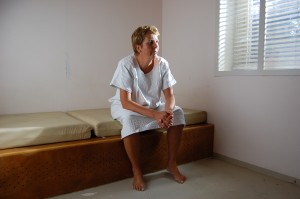In 2009 I was appointed the Artistic Director of the 3rd International Madness & Arts Festival (MAF 3), a multi-disciplinary festival about art and psychiatry. The festival was coming to the Netherlands only once and was taking place in twenty cultural institutions and locations in Haarlem and on the festival site behind Museum Het Dolhuys, from September 24th to October 3rd, 2010.

MAF3 offered a high-quality programme with theater, dance, film, music, visual arts, literature and discussions. Especially for the festival, the participating institutions adapted their programme to the theme of the festival. Next to this, the Madness & Arts Festival realized a number of new productions, amongst others the Night of Madness hosted by Belgian comedian Wim Helsen; the new film People in White by the artists duo Tellervo Kalleinen & Oliver Kochta-Kalleinen; a temporary installation by Dutch artist Marisca Voskamp; and an international symposium on art and psychiatry, in collaboration with Museum Het Dolhuys, VUmc, VU Connected and the Global Initiative on Psychiatry.
Please have a look at the full programme of MAF3 here
Read the interview with me in Metropolis M here
The importance of the Madness & Arts Festival
‘Madness’ has a strong magnetic hold on us. Fascination and fear compete for first place. We delight in the lopped ear of Van Gogh or the ups and downs of Amy Winehouse, but recoil the moment we are addressed by a mentally disturbed person in the street or brought face to face with our own psychological problems. On the one hand we entertain a Romantic picture of madness, on the other hand people with a serious psychological disorder are often confronted with negative prejudices. They are supposed to be dangerous, unreliable, incompetent, careless and incurable. These stereotypes are persistent and are reinforced by reporting in the media and by the portrayal of psychiatric patients in films and on television.
The aim of the Madness & Arts Festival is to remove the stigma from ‘madness’ on a variety of fronts. One way is to show the public that the boundary between ‘mentally healthy’ and ‘disturbed’ is much more blurred than people think, and that it is not just a question of extreme disorders but also of common psychological problems such as depression, dementia and eating disorders. Another is to make the public aware that the Romantic idea of the ‘tormented, creative mad genius’ ignores the actual, dark aspects of psychological problems that do not die away when the stage lights go out.
The way in which psychological problems are represented – both in the media and by artists – has a major influence on what we regard as mad and normal. History shows that mental representations of psychological disorders are changing all the time. Who was once regarded as out of his mind may be seen today as an exceptionally creative talent, and tomorrow perhaps as a patient.
Which presuppositions determine how we picture psychiatric disorders today? Can art exert a positive influence on the stereotypes? Which labels do we attach to art made by people with a psychiatric background? These are all questions that the 3rd International Madness & Arts Festival wants to explore on the basis of a wide-ranging programme in the field of theatre, dance, literature, music, art, film and debate.







